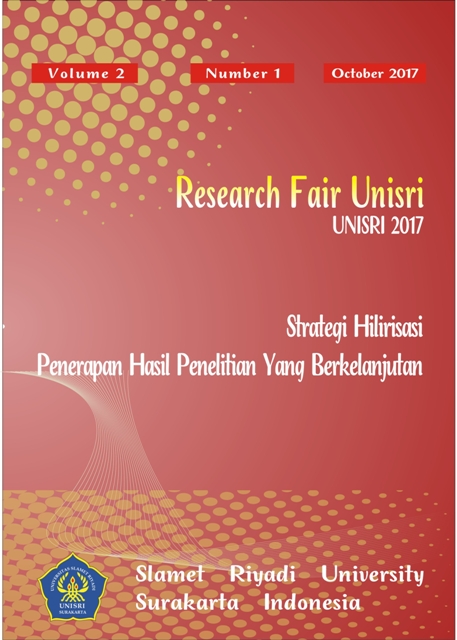EFSIENSI PEMBUATAN BIODISEL DARI MINYAK GORENG BEKAS MELALUI PROSES NETRALISAI DAN TRANSESTERIFIKASI
DOI:
https://doi.org/10.33061/rsfu.v2i1.2022Abstract
The purpose of this research is to improve the efficiency of making biodiesel from used cooking
oil. Used cooking oil has a high fatty acid content that is high enough that when processed into
biodiesel through transesterifikasi will occur blocking the reaction of biodiesel formation. Blocking the
reaction results in doubling methanol demand and the separation of biodiesel becomes difficult due to
the formation of soap so that the resulting yield decreases, so the method is less efficient. The process
of free fatty acid removal through neutralization takes less time. The neutralization process is also
cheaper because it requires only a small amount of NaOH so that the making of biodiesel from cooking
oil through the neutralization-transesterification process is more efficient in terms of time and cost.
To obtain the best transesterification process condition, the effect of temperature variation (30 oC, 40
oC, 50 oC, 60 oC, 70 oC) on yield of biodiesel produced, variation of KOH catalyst concentration
(0.75%, 1%, 1, 25%, 1.5%, 1.75%) on the yield of biodiesel produced and the effect of variation of
methanol-oil molar ratio (6: 1; 7: 1; 8: 1; 9: 1; 10: 1) on biodiesel yield which is produced from used
cooking oil. The results showed at 60 ° C, KOH 1% catalyst concentration and a 6: 1 molar methanoloil
ratio resulted in a maximum biodiesel yield of 87.3%.
Keywords: efficiency, biodiesel, used cooking oil
References
Bustomi, S.,Tati Rostiwati, T., Sudradjat, R., Leksono, B., Kosasih, S., Anggraeni, I.,
Syamsuwida, D., Lisnawati, Y., Mile, Y., Djaenudin, D., Mahfudz, Rachman, E.
(2008). Nyamplung (Calophyllum inophyllum L.) Sumber Energi Biofuel yang Potensial.
Jakarta: Badan Litbang Kehutanan.
Crane, Sylvie et al, (2005), Composition of fatty acids triacylglycerols and
unsaponifiable matter in Calophyllum calaba L. oil from Guadeloupe,
Phytochemistry, vol.66, hal.1825 – 1831
Hingu, S.M., Gogate, P.R., Rathod, V.K. (2010). Synthesis of from Waste Cooking Oil using
Sonochemical Reactors. Ultrasonics Sonochemistry 17: 827–832
Kansedo, J., Lee, K.T. and Bhatia, S. (2008). Biodisel Production from Palm Oil via
Heterogeneous Transesterification. Biomass Bioenergy. 33: 271–276.
Koh, M.Y., Mohd, T.I. and Ghazi. (2011). A Review of Production from Jatropha Curcas L.
Oil. Renewable and Sustainable Energy Reviews 15 : 2240–2251
Leung, D.Y.C., Wu, X. and Leung, M. K. H. (2010). A review on Production Using Catalyzed
Transesterification. Applied Energy 87: 1083-1095
Meher, L.C., Vidya S..D. and Naik, S.N. (2004). Technical Aspect of Biodisel Production by
Transesterification. Renewable and Sustainable Energy Reviews 10: 248-268.
Mendow, N.S., Veizaga, B.S. and Sanchez, C.A. (2011). Biodisel Production by Two-Stage
Transesterification with Etanol. Bioresource Technology 102: 10407–10413
Prihanto, A., Pramudono, B. dan Santosa, H. (2013). Peningkatan Yield Biodisel dari Minyak
Biji Nyamplung Melalui Transesterifikasi Dua Tahap. Momentum 9 :46 - 53
Ramadhas, A.S., Jayaraj, S.and Muraledharan, C. (2004). Biodisel Production From high FFA
Rubber Seed Oil. Fuel 84 : 335 – 340.
Venkanna, B.K. and Venkataramana, R.C. (2009). Biodisel Production and Optimization
from Calophyllum Inophyllum Linn Oil (Honne Oil) – A Three Stage Method.
Bioresource Technology 100: 5122–5125
Wang, R., Zhou,W.W., Hanna, M.A., Zhang, Y.P., Bhadury, P.S., Wanga, Y., Song, B.A. and
Yang, S. (2012). Preparation, Optimization, and Fuel Properties from Non-Edible
Feedstock,Datura Stramonium L. Fuel 91: 182–186
Downloads
Published
Issue
Section
License
- Hak publikasi atas semua materi informasi yang tercantum dalam situs jurnal ini dipegang oleh dewan redaksi/editor dengan sepengetahuan penulis. Pengelola Jurnal akan menjunjung tinggi hak moral penulis.
- Aspek legal formal terhadap akses setiap informasi dan artikel yang tercantum dalam situs jurnal ini mengacu pada ketentuan lisensi Creative Commons Atribusi-NonCommercial-No Derivative (CC BY-NC-ND), yang berarti bahwa hanya dengan izin penulis, informasi dan artikel Jurnal PKM dapat didistribusikan ke pihak lain dengan tanpa merubah bentuk aslinya untuk tujuan non-komersial.
- Setiap terbitan Jurnal PKM, baik cetak maupun elektronik, bersifat open access untuk tujuan pendidikan, penelitian, dan perpustakaan. Di luar tujuan tersebut, penerbit atau pengelola jurnal tidak bertanggung jawab atas terjadinya pelanggaran hak cipta yang dilakukan oleh pembaca atau pengakses.




















